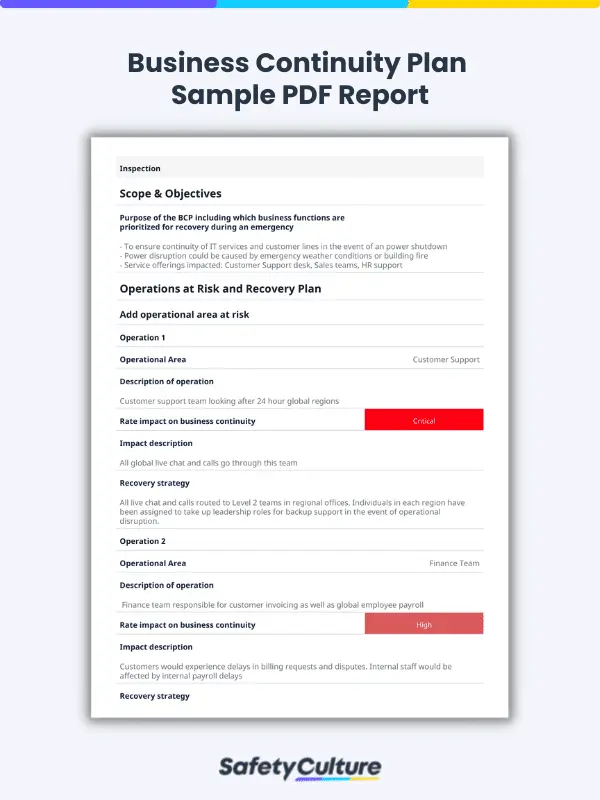What is a Business Continuity Plan?
A business continuity plan is a practical guide developed by companies to enable continuous operations in the event of major business disruptions like natural disasters and global lockdowns. Business continuity planning usually involves analyzing the impact of disrupted business processes and determining recovery strategies with management. Business continuity plans should also be properly documented and tested through exercises for optimal effectiveness.

Business Continuity Plan | View Sample PDF
The goal of a business continuity plan is to strengthen the defense of businesses against a number of potential disruptions. It also aims to maintain critical business functions during unforeseen disasters. With a comprehensive business continuity plan, leaders can ensure that despite restrictions, there would be a reduced impact on the company, its employees, and operations.
Why Is It Important?
With economies impaired by the COVID-19 pandemic, business continuity has increasingly become a top priority for organizations around the world. A business continuity plan (BCP) is important because it helps companies maintain essential functions amid or after emergency situations, protecting their reputation and minimizing financial losses. Moreover, it helps employers stay on top of disruptive incidents and empower workers to complete job tasks with confidence.
Business Continuity Plan vs. Disaster Recovery Plan
The main difference between a business continuity plan and a disaster recovery plan is that the former encompasses the latter—that is, business continuity planning includes disaster recovery planning. ISO 22301:2019 is the international standard for business continuity management (BCM) systems, and it outlines how specific plans for disaster recovery, incident preparedness, and emergency response may be needed rather than just one large plan for business continuity.
What are the 7 Elements of a Business Continuity Plan?
When the COVID-19 pandemic hit the world, the economy took a massive hit. The need for a business continuity plan became more apparent to organizations. Business continuity planning enables businesses, small or large, to build a more resilient operation.
A Business Continuity Plan should include:
1. BCP Team
In the midst of a disaster or emergency, having a team or point person to go to will be essential. The BCP team will be responsible for planning and testing business continuity strategies. Background of each member in the BCP team can vary from organization managers or supervisors to specialists.
2. Business Impact Analysis
A business impact analysis (BIA) identifies, quantifies, and qualifies the impact of a loss, interruption, or disruption. Having a BIA will be essential in discovering risks that your business is exposed to and the potential disruptions that may occur.
3. Risk Mitigation
This element pertains to the strategies against the risks that were discovered during the BIA. Risk mitigation strategies may include putting up security and safety systems in the workplace, conducting preventive maintenance of vehicles, machines, equipment, or any asset vital to operations, and training of employees, among others.
4. Business Continuity Strategies
A good business continuity plan should establish strategies or alternate practices to keep the business running despite disruptions or disasters. An example of a continuity strategy that a lot of businesses had to implement during the pandemic was remote working or work-from-home. This enabled businesses to continue their operations and keep their employees safe from contracting COVID-19 in the workplace.
5. Business Continuity Plan
The business continuity plan is a combination of findings from the performed BIA and the recovery strategies established by the organization. A BCP plan typically includes 4 key components: scope & objectives, operations at risk, recovery strategy, and roles and responsibilities.
6. Training
All relevant personnel associated with the business continuity, disaster recovery, and incident response process should be trained according to the BCP plan that’s established and agreed upon.
7. Testing
In the testing phase, strategies and plans are being rehearsed or exercised to demonstrate its effectiveness. Testing the plan before rolling it out will enable the BCP team to discover potential flaws and fix them before they lead to damage or injury. It is recommended to review and test the plan periodically to ensure that all protocols and strategies are up-to-date.
Scale Your Enterprise Operations with Customizable Solutions
✓ Scale ✓ Data ✓ Security ✓ Integration ✓ Teams
Learn MoreHow to Write a Business Continuity Plan
Creating a business continuity plan seems to be a daunting task at first, especially for managers of operations, information technology, and human resources as they are often designated with this duty. As recommended by the International Labour Organization (ILO), listed below are general steps in developing a business continuity plan for small to medium sized enterprises (SMEs):
- Step 1: Determine the risk profile through a self-assessment using the 4Ps framework—People, Processes, Profits, and Partnerships
- Step 2: Identify key products, services, or functions
- Step 3: Establish the business continuity plan objectives
- Step 4: Evaluate the potential impact of disruptions to the business and its workers
- Step 5: List actions to protect the business
- Step 6: Organize contact lists
- Step 7: Maintain, review, and continuously update the business continuity plan
Business Continuity Plan Example
When planning for business continuity, it helps to break down its elements into quickly-understood segments. Keeping the plan user-focused can also help ensure usability and promote transferability. The following is a brief ILO example of how a small business owner developed a business continuity plan to mitigate the impact of COVID-19:
COVID-19 Risk Assessment: high-risk profile
Key Products: different types of canned sardines
Objectives:
- Maximize the physical and emotional safety of the owner and workers
- Resume operations as quickly as possible following disruptions
- Make sure that key products are resilient to disruptions associated with COVID-19
- Safeguard supply chain
- Ensure that the enterprise fulfils its contractual commitments with clients
Potential Impact of Disruptions:
- Workers falling sick (owner’s/suppliers’/support services’)
- Government restrictions on freedom of movement could affect the owner’s (and the suppliers’) ability to get to work
- Government restrictions on accessing the port could affect the customers’ ability to get the products to market
- Inability of government utilities to provide services (water and electricity were of chief concern)
- Drop in demand for products
4Ps Framework Action Points:
- People (lives of workers and family members)
Limit the contact points to a single one in the business and set up a sanitation point to lessen the exposure there. Review the standard ways of working and adapt to physical distancing criteria. This would require new shift arrangements to be discussed with the workers. Moreover, prepare for increased absenteeism.
- Processes (business operations)
Ask workers to volunteer for ensuring sanitation points are well-stocked daily, establishing a temperature checking station at entrance for all workers/suppliers/customers/visitors, daily consultation with suppliers and customers to assess their situation and any changes that have occurred, and making sure everybody is familiar with ways to stay safe at home.
- Profits (revenue generation)
Work out daily operational costs (payroll, rent, supplies, etc.) and make simulations based on the financial needs if key disruptions occurred. Notice opportunities for increased sales as well. Discuss with main suppliers about the availability of alternative sources and put agreements in place to enable this.
- Partnerships (enabling environment to carry out business activities)
Strike an agreement with other SME owners to share safety measures and practices for each of their businesses. Agree to a common set of procedures to keep workers safe and share the cost of getting information on how to handle workplace issues like changes to working time, possible redundancies, and other HR issues.
Contact Lists:
- Contact numbers of authorities and third parties (police, emergency services, firefighters, nearest hospitals, insurance company)
- List of workers, their positions and contact details (mobile phone and email address) as well as worker’s emergency contact details
- List of clients, suppliers, contractors and government agencies the owner worked with, including the contact person and details (mobile phone, email address, and street address)
- Communication methods to connect with workers during the COVID-19 crisis (Facebook, WhatsApp, etc.)
- Staff emergency call tree
Updates:
- Review the business continuity plan every week to improve its effectiveness
- Update risk assessments, strategies for business continuity, and other procedures
- Ensure continual improvement of all the process included in the business continuity plan
Another simple example of a business continuity plan is the following:
Scope and Objectives:
This BCP is to ensure the continuity of IT services and customer lines in the event of an unforeseen and prolonged power shutdown. Power disruption could be caused by emergency weather conditions or a building fire. Functional areas that are prioritized for recovery in this BCP include the customer support desk and finance team.
Operations at Risk:
Operation: Customer Support
Operation Description: Customer support team looking after 24-hour global operations of live chat and customer calls for US, EMEA and APAC regions
Business Impact: Critical
Impact description: 100% of live chats go through the customer support team in Manila. 20% of live calls are routed to Manila office. A disruption would mean no more live chat support and customers experiencing significant wait times on calls Project timeline and team schedules
Recovery Strategy:
IT personnel and BCP committees should operate alternate backup programs and servers to help save customer requests after power outage. Customer support should be able to receive the requests and respond to customers within 30 minutes. IT Director should operate alternate server rooms in Area B if the power outage last more than an hour to prevent huge revenue loss.
Roles and Responsibilities:
Representative: Jon Sims
Role: Head of Operations
Contact Details: jsims@example.org
Description of Responsibilities:
1. Must ensure BCPs are updated and must coordinate with team leaders regarding changes
2. Helps notify key stakeholders in EMEA region of threats in Customer Support programs & tools
Digitize the way you Work
Empower your team with SafetyCulture to perform checks, train staff, report issues, and automate tasks with our digital platform.
Get Started for FreeCreate an Effective Business Continuity Plan with SafetyCulture
Even when disruptions can force businesses to shut down, yours doesn’t have to. Aim for operational stability by developing and implementing a business continuity plan with the help of a simple tool like SafetyCulture (formerly iAuditor). SafetyCulture is a digital platform that empowers people to work safely and efficiently through mobile checklists, actions, and reporting.
Using SafetyCulture as a business continuity software, here’s how different companies around the world reached business continuity amid COVID-19:
Coming Out Strong as the Pandemic Unfolded
Footasylum is a sports fashion retailer in the UK with 70 stores and over 2,700 employees nationwide. Because of the emerging novel coronavirus outbreak, they knew it was inevitable for retail stores to close without an idea when they could safely reopen.
They used SafetyCulture to safely reopen stores by conducting a preliminary COVID-19 store opening check which provided incredibly quick insight on the current state of the stores and created actions for what needed to be done to control health and safety risks.
Now that stores are open, the team uses SafetyCulture to monitor daily activity through a retail COVID-19 daily requirements check, giving the management confidence that they are doing everything that is reasonably practicable to ensure the safety of their staff and customers.
“We have come out of this as a really strong team, and pride is really high,” said Jane Buck, Head of Human Resources and Health and Safety.
Acting at Lightning Speed to Protect Hundreds of Staff and Thousands of Customers
Statewide Independent Wholesalers (SIW) is a grocery wholesaler that holds and delivers goods for most of the major supermarkets in Tasmania, Australia. When COVID-19 hit, they needed to make decisions quickly due to the risk which was significantly high.
The grocer giant stayed completely focused on meeting COVID-19 hygiene and distancing requirements, as they do around 75 checks every week. Health, Safety, and Environmental Manager Courtney Newman shared, “SafetyCulture is a really valuable tool to do that. It’s made a huge difference to our data collection, and our behavior observation space, too.”
They managed to minimize 6.5 hours of admin time which was useful when they needed that time to keep themselves informed on the latest news and guidance. Courtney continued, “I took the SafetyCulture program and used it the way I wanted to. This means if any of our teams are doing anything of risk, we work with them to make sure they adhere to the guidelines.”
Navigating the Pandemic and Beyond with Safety, Consistency, and Quality
Snooze Eatery is a popular chain of restaurants with 43 locations in the US. During one of the most uncertain periods for hospitality businesses, they used SafetyCulture to build up a culture of safety, consistency, and quality.
During reopening, the team created the brand new role, ‘Safety Dancers’, who are in charge of cleaning, sanitizing, and managing the capacity of the eatery. This meant that guests could trust the safety and cleanliness standards of the restaurant, and enjoy a cup of coffee in bliss.
SafetyCulture has allowed them to reassure their employees and guests during a time where trust in public spaces is low because of the potential health and safety risks. They also don’t just implement COVID-19 protocols with SafetyCulture—it’s a safeguard for food and service quality across all their locations.
“It’s a unique tool. The inspections and templates make you go through a checklist, but it also makes you give proof in the form of photos and notes, and to take care of things on the spot. It holds you to the utmost perfect standard in every way.”
—Katie Birner, Snooze Eatery Assistant General Manager
Achieve operational excellence
Cultivate a culture of excellence with our digital solutions that enhance efficiency, agility, and continuous improvement across all operations.
Explore nowFAQs about Business Continuity Plans
Business continuity planning is important because it helps organizations protect their business amid a crisis or emergency. A business continuity plan contains instructions that will serve as a guide for the organization to maintain its operations.
A business continuity plan should be tested at least every 6 months to verify the BCP’s effectiveness. Frequent testing can also allow the discovery of gaps and potential issues. This will help the organization update protocols and strategies accordingly.




